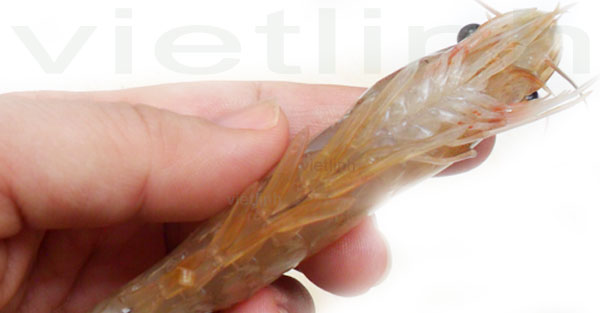
The disease occurs year-round on species such as black tiger prawn, whiteleg shrimp, giant river prawn, etc. The disease can occur in all stages of growing, from egg to adult shrimp.
Luminous Bacteria Disease thrives in nutrient-rich water with organic substances, high salinity, low dissolved oxygen, and spreads quickly in hot weather.
Symptoms:
- Shrimp is weak, swims in a non-directional path, appears along edges, pond corners, and responds slowly.
- Shrimp body and gill have dark, dirty and muddy color. Liver is inflamed, shrink, and loses its digestive function for shrimp.
- Shrimp reduces eating. There are no feed and feces in shrimp intestine. Shrimp feces in the feeding tray are not much.
- Shrimp head and body glow in white-green colors in the dark.
- Observe under the microscope, glowing bacteria are seen to be moving in shrimp muscle and blood.
- There are little luminous points on shrimp meat
- Shrimp grows slowly. Surface fouling may occurs in shrimp gills and shells.
- Shrimps die scatteredly depending on the severity of the disease. If the disease infects 100% shrimps during the beginning 45 days of culture, shrimps may die in series.
- Infected shrimp larvae have milky color. If they are seriously infected, larvae will submerse under the nursery tanks and die in a massive amount.
Diagnostic methods:
- Recognize the symptoms.
- Tested by TCBS Agar test kit (use thiosulfate citrate bile sucrose agar environment) to detect the bacteria.
Cause:
- The bacteria are in the group of Luminescencet Vibrio; the main and most dangerous is Vibrio harveyi. These bacteria have the enzyme Luciferase that causes light emission.
- In the group of Gram-negative bacteria, they grow in the salinity of 10-40ppt (strongest in the salinity of 20-30 ppt).
- These bacteria are resistant to many antibiotics.
- Disease can be infected from hatcheries, nurseries into farming pond. In hatchery, pathogen is spread mainly through mothers-to-larvae intestine in the reproductive phase.
Compiled by ©2015 Viet Linh